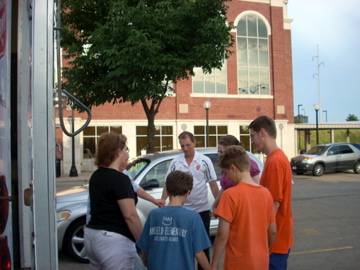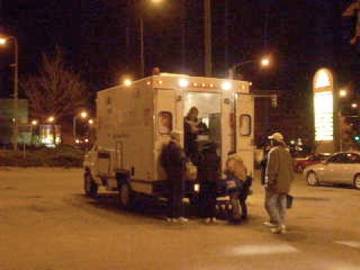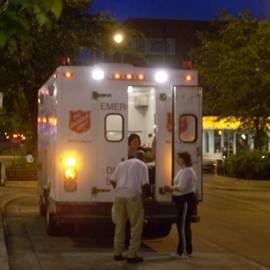 The 60s brought in a lot to this country; everything changed. Attitudes went in every different direction. Morality, respect for government, attitudes toward war and patriotism, the way we run schools, what was cool and not cool, tons of slanguage, probably every aspect of society — everything — and many of those changes are still present. But, curiously, as I remember it, there were no homeless. It was not a word in our cultural lexicon.
The 60s brought in a lot to this country; everything changed. Attitudes went in every different direction. Morality, respect for government, attitudes toward war and patriotism, the way we run schools, what was cool and not cool, tons of slanguage, probably every aspect of society — everything — and many of those changes are still present. But, curiously, as I remember it, there were no homeless. It was not a word in our cultural lexicon.
Of course, there were homeless. The Depression caused a lot of homelessness, but post WW II was a boom time for much of the U.S. and we categorized these people as hobos (kindly) and bums (unkindly) and even romanticized the lifestyle quite a bit. So there were homeless; they were just not on the national radar. And there were no shelters that anyone knew much about though they were, of course, in all major cities. But not in the heartland. Not in places like Champaign-Urbana.
All of that changed under Reagan, who pretty much ripped apart the safety net. Combined, strangely, with the liberal push to get the mentally ill out of institutions, before long the word “homeless” was a household word, so to speak, and shelters began to crop up everywhere with virtually every city area having one or, in bigger cities, many.
A great deal of these were started by churches that opened their doors to these new “homeless.” Because their situation was not temporary anymore. in every city, there were the permanent homeless and the push was not to get them into homes, though there were and are many noble efforts to do so, but the major thrust was to build shelters. This shift on the U.S. landscape was not going away and has not; ironically for those who wanted the mentally ill out of institutions, what has come about is simply another kind of institution: the Homeless Shelter.
I was one of those who helped start the first men’s shelter in town (it took awhile to acknowledge that there were homeless women and kids too) in the basement of a sanctuary at the McKinley Presbyterian Church on the U of I campus.
It was open seven nights a week, served food — breakfast and dinner — and we washed the clothes of the men who occupied the many cots. Men could come in at 9 p.m. but had to leave by 7 a.m. and rousing them out the door was not the most fun I have ever had, especially in the winter. This shelter was totally staffed by volunteers from area churches and the men who did this (with the help of one underpaid coordinator) stayed up all night and washed the clothes and prepared the breakfast after having served dinner (mostly soup from different churches) and cleaned up to start the evening and end the morning.
That Shelter became the Times Center, built and funded by the government, and now we also have the Center for Women in Transition. The Salvation Army (which was always there), Christ-centered Restoration Urban Ministries and the Catholic Worker House, and other efforts that have come and gone. There is even a shelter for battered women. In our community, there is a place for the homeless, a permanent place, as is appears that this part of the populace will never go away.
 There is another outreach to the Homeless that has been going now for about five years. It is run by this wonderful lady, Barb Davies and her husband Dan and a whole lot of volunteers. The Canteen truck runs when people go out two evenings a week, all year round. It is entirely supported by donations, allowing these folks to find the people and serve them.
There is another outreach to the Homeless that has been going now for about five years. It is run by this wonderful lady, Barb Davies and her husband Dan and a whole lot of volunteers. The Canteen truck runs when people go out two evenings a week, all year round. It is entirely supported by donations, allowing these folks to find the people and serve them.
I have known about this outreach for some time and decided to write a story unabashedly for the purpose of getting them more volunteers and more donations (more on that later). So I decided it would be a good idea to actually go on the Canteen Run so as to be able to do some first hand reporting.
But first a bit about the Davies. Her husband said I could tell you: she is on medication for seizures. That is why the Run stops at 9 p.m. If she takes her meds and gets enough sleep she is fine. Dan has a regular job; Barb’s job is to organize the Canteen Run, get donations, do speaking for it, and personally follow up on real life situations she encounters. There are many. She always has a wonderful smile, a gentle, light-laugh-in-it voice, a caring touch. She really has learned to relate to people, all people. She wants the Run to go out more nights. I believe it will. Her faith is a strong motivator as is her obvious love for the people she serves. I was glad I got to go with Barb and her crew. I will be back.
I went out with this group on a Thursday evening a few weeks back. There were seven of us who volunteered that evening, meeting at the Salvation Army on Market Street and going to various places until about 9 p.m, their regular routine. The number of volunteers varies night to night; there had been 39 teens from a church youth group the Monday before. But this night, there were the Davies, me, a faithful, regular lady named Melanie, a lady from an area church, a freshman in high school, and a young Congolese man who is a refugee from that war-torn country.
We went out in a well-equipped truck provided by the Salvation Army which also allows them to take PBJ sandwiches and snacks of various kinds and bottled water in this hot weather. (I saw large packets of hot chocolate for other times.) Basically, we followed a route they frequently take. Tonight we started at the Illini bus terminal, went to the Champaign Library lot, then to Scott Park and walked around there and the whole Boneyard area.
And we found people, some who knew and anticipated our coming, others who we just found. Most eagerly and gratefully took the water, food bags, socks, underwear, and toiletries. Many received simple prayer. And they were asked what they wanted. This was not a hand out situation; it was very relational. Often it was like visiting friends you had not seen for awhile, even for a newbie like me.
Stories: First of all, a lot of no stories. Just unnamed people getting, water, food and the above. Always very grateful, very respectful. Good banter, some prayer.
Some clearly homeless, some, no way of knowing. (When we walked around various areas there were often not people but sleeping bags in various nooks and bushes that spoke of how and where some people live.)
By the library: One young man told of going to get a job in Rantoul at a place that cuts up pigs after they are slaughtered and trucked to this factory where they are cut apart in a scene right out of Sinclairs’ The Jungle. He was confident of getting the job. “Lots of turnover, nasty, dangerous, bloody work. Been there before. Can only last so long. Minimum wage, but some benefits. Last man standing. They have a hat system. As you move up you get a different colored hat and a bit more money. I only got the first hat — blue.”
He was very grateful for the food and underwear he got.
Another: An older couple drove up, referred by an area church; they live out of their car because his job requires a car and so they kill two birds. Both diabetic. Someone in the church had contacted Barb and donated a plug-in cooler to keep their insulin safe. They could plug it into the cigarette lighter. Life saving.
This one: A worker at the library sprinted out and got the dope on how he could volunteer, then sprinted back.
A gem: Found out that Stone Creek Church has a 5:30 p.m. service for Congolese refugees every Saturday night which two refugees who received food told us.
Another: By Scott Park we looked for a man whom Dan had convinced to go into de-tox, but he did not appear that night.
In campus: By the Boneyard, a young mother, visiting her father, with three daughters and a niece up from St. Louis. Said no to the water but when she saw the truck and found out there was food, took some for herself and each child, and toiletries, underwear, and yes, then the water and was misty eyed and received prayer.
Again, from campus: A number of families, just walking by, all took water, most food. Then a large older man and his wife came up, came right up to me. “Oh,” he cried, as if I had been there, “these people saved us. Last winter we had nothing, We were freezing. We were up from Louisiana. No job; I had hurt my back. They gave us blankets, food. We would not have made it. ” He took the food and water with so much gratitude and asked for prayer.
 Barb and her crew make everyone feel special. They are casual as they hand anything out. They size the clothing, the t-shirts and underwear they have. They ask what kind of toiletries. Nothing is rushed. Everything is given with a smile, conversation, concern. Some linger a while, some move on soon. One man at the Terminal kept letting everyone go in front of him to get the various items first. “I don’t mind; I have lots of time.”
Barb and her crew make everyone feel special. They are casual as they hand anything out. They size the clothing, the t-shirts and underwear they have. They ask what kind of toiletries. Nothing is rushed. Everything is given with a smile, conversation, concern. Some linger a while, some move on soon. One man at the Terminal kept letting everyone go in front of him to get the various items first. “I don’t mind; I have lots of time.”
Simply, you can help. You can volunteer and I recommend it as it gives most of us a different perspective on ourselves, our town, our view of the world. You can donate non-perishable food. And you can donate money. The Canteen Run has just acquired an ambulance which they are refurbishing so they can have their own vehicle. They need about $4000 to do this. So if you want to do any of the above, contact Barb at 217-372-6560, bjd830@sbcglobal.net or check out their website: http://tinyurl.com/canteenrun. Also, they are on FaceBook with a link called How to Volunteer. Thank you.








